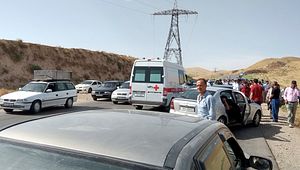Tajik authorities have officially dismissed the Islamic State as the force behind the July 29 car attack, which killed four foreign cyclists in southern Tajikistan. In a statement, the Tajik Prosecutor General’s Office categorically rejected the possibility that the attack was carried out by the Islamic State, despite significant evidence to the contrary.
Instead, the Tajik authorities claim the Islamic Renaissance Party of Tajikistan (IRPT, sometimes translated as Islamic Revival Party) is responsible for the attack and that the video released of the alleged attackers pledging allegiance to the Islamic State’s leader is a diversionary tactic.
The statement, released on August 4 and subsequently in English, states that the dissemination of information on the Internet that the attack was organized by the Islamic State was “directed with the aim of removing suspicions from the terrorist organization ‘Islamic Revival Party,’ which is the main customer of this terrorist act.”
As I discussed with The Diplomat‘s Ankit Panda on a podcast last week, the evidence to support the conclusion that the attack was at least inspired by the Islamic State is considerably compelling.
First, a car ramming into pedestrians or cyclists fits into an established pattern of attacks carried out by Islamic State supporters. In the November 2016 issue of its English-language magazine, Rumiyah, the Islamic State encouraged followers to use vehicles in attacks because “Vehicles are like knives, as they are extremely easy to acquire [and] . . . arouse absolutely no doubts due to their widespread use throughout the world.”
A pattern of car attacks emerged following the magazine’s publication including: November 28, 2016 in Columbus, Ohio; December 16, 2016 in Berlin; March 22, 2017 in London; April 7, 2017 in Stockholm; June 3, 2017 in London; August 17, 2017 in Barcelona; and October 31, 2017 in New York City.
Of course, a tactic knows no allegiance — more evidence is necessary and, in this case, has appeared.
On July 30, the Islamic State’s internal news agency claimed responsibility for the attack in Tajikistan. The Islamic State’s bulletin claiming the attack described those involved as “soldiers of the Islamic State.” The next day, the Islamic State released a video purportedly of the attackers sitting before a black Islamic State flag and pledging allegiance to the Islamic State’s leader, Abu Bakr al-Baghdadi.
While difficult to verify, the young men in the video resemble some of those the Tajik government claimed were responsible for the attack and subsequently killed by police.
There is little apparent reason, in this case, to doubt the Islamic State’s claim of a connection to the attack. While it is unclear if the attack was plotted abroad or conceived among the young men themselves, the inspiration certainly appears to derive from the Islamic State and its propaganda.
Nevertheless, Tajikistan seems intent on placing blame for the attack on the IRPT. As we’ve covered here at The Diplomat, since 2015 Dushanbe has engaged in a targeted campaign to destroy the IRPT. The once-legal political party was squeezed out of parliament, downsized, then delegalized and branded a terrorist group. Its leaders (and their lawyers) have been arrested or forced to flee abroad and the relatives of opposition activists who remain in Tajikistan have been essentially turned into hostages by the authorities, often unable to leave the country and frequently called in for questioning.
Artemy M. Kalinovsky, an assistant professor at the University of Amsterdam and author of a recent book on Soviet Tajikistan, noted recently that Dushanbe’s version of events is “quite implausible” and “reflects the regime’s obsessions in domestic politics.” Kalinovsky remarks on the implausibility by noting the IRPT’s participating in Tajikistan’s parliament following the end of the civil war and the fact that:
Even in exile [the IRPT] has continued to call for opposition to the regime using democratic means; it has not expressed any interest in fomenting an armed uprising within Tajikistan. Nor has it ever espoused any particularly xenophobic views about Europeans or anyone else. On the contrary, both before and after his exile, Kabiri has always looked to Europe to pressure the regime of Emomali Rahmon, president since 1992, to live up to its promises. In short, while it cannot be ruled out that some of the attackers may have once been IRPT followers, it is highly unlikely the group had any involvement in the attacks.
Ironically, the Prosecutor General’s statement dismissing the Islamic State connection as a false flag noted that the attack was aimed at creating “an atmosphere of fear and panic in society and damaging the image of Tajikistan in the international arena.” While the attack itself has already made a dent on Tajikistan’s tourism industry, the image of the country has been most damaged by the policies of its government.































